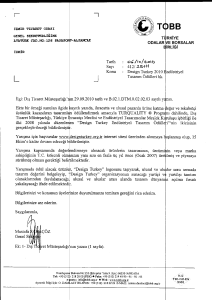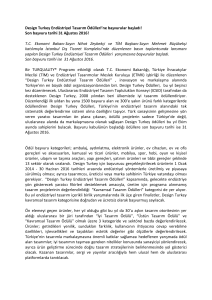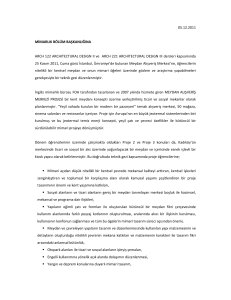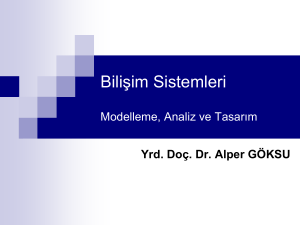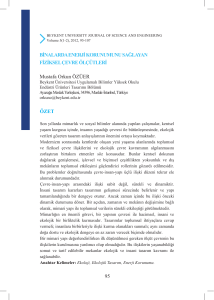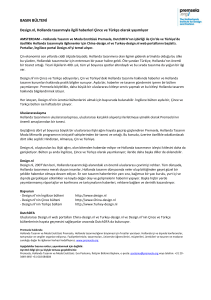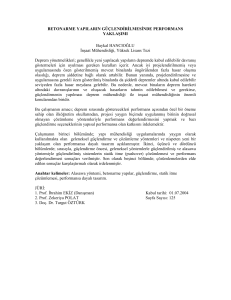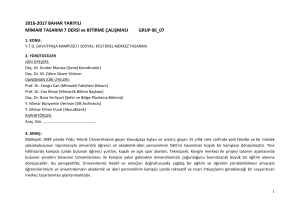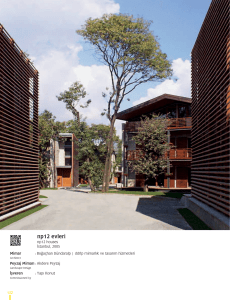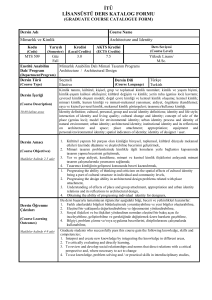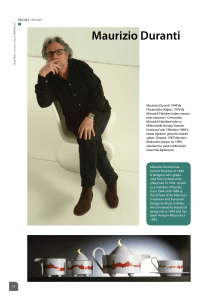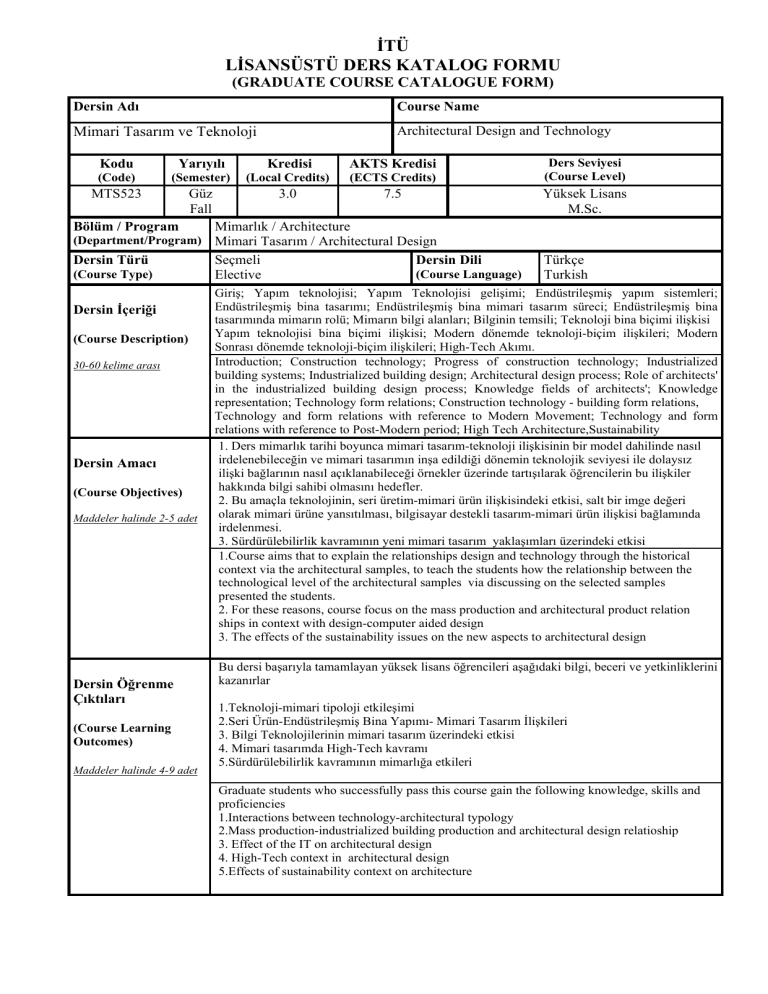
İTÜ
LİSANSÜSTÜ DERS KATALOG FORMU
(GRADUATE COURSE CATALOGUE FORM)
Dersin Adı
Course Name
Mimari Tasarım ve Teknoloji
Architectural Design and Technology
Kodu
Yarıyılı
Kredisi
AKTS Kredisi
(Code)
(Semester)
(Local Credits)
(ECTS Credits)
MTS523
Güz
Fall
3.0
7.5
Bölüm / Program
(Department/Program)
Dersin Türü
(Course Type)
Dersin İçeriği
(Course Description)
30-60 kelime arası
Dersin Amacı
(Course Objectives)
Maddeler halinde 2-5 adet
Dersin Öğrenme
Çıktıları
(Course Learning
Outcomes)
Maddeler halinde 4-9 adet
Mimarlık / Architecture
Mimari Tasarım / Architectural Design
Seçmeli
Dersin Dili
(Course Language)
Elective
Ders Seviyesi
(Course Level)
Yüksek Lisans
M.Sc.
Türkçe
Turkish
Giriş; Yapım teknolojisi; Yapım Teknolojisi gelişimi; Endüstrileşmiş yapım sistemleri;
Endüstrileşmiş bina tasarımı; Endüstrileşmiş bina mimari tasarım süreci; Endüstrileşmiş bina
tasarımında mimarın rolü; Mimarın bilgi alanları; Bilginin temsili; Teknoloji bina biçimi ilişkisi
Yapım teknolojisi bina biçimi ilişkisi; Modern dönemde teknoloji-biçim ilişkileri; Modern
Sonrası dönemde teknoloji-biçim ilişkileri; High-Tech Akımı.
Introduction; Construction technology; Progress of construction technology; Industrialized
building systems; Industrialized building design; Architectural design process; Role of architects'
in the industrialized building design process; Knowledge fields of architects'; Knowledge
representation; Technology form relations; Construction technology - building form relations,
Technology and form relations with reference to Modern Movement; Technology and form
relations with reference to Post-Modern period; High Tech Architecture,Sustainability
1. Ders mimarlık tarihi boyunca mimari tasarım-teknoloji ilişkisinin bir model dahilinde nasıl
irdelenebileceğin ve mimari tasarımın inşa edildiği dönemin teknolojik seviyesi ile dolaysız
ilişki bağlarının nasıl açıklanabileceği örnekler üzerinde tartışılarak öğrencilerin bu ilişkiler
hakkında bilgi sahibi olmasını hedefler.
2. Bu amaçla teknolojinin, seri üretim-mimari ürün ilişkisindeki etkisi, salt bir imge değeri
olarak mimari ürüne yansıtılması, bilgisayar destekli tasarım-mimari ürün ilişkisi bağlamında
irdelenmesi.
3. Sürdürülebilirlik kavramının yeni mimari tasarım yaklaşımları üzerindeki etkisi
1.Course aims that to explain the relationships design and technology through the historical
context via the architectural samples, to teach the students how the relationship between the
technological level of the architectural samples via discussing on the selected samples
presented the students.
2. For these reasons, course focus on the mass production and architectural product relation
ships in context with design-computer aided design
3. The effects of the sustainability issues on the new aspects to architectural design
Bu dersi başarıyla tamamlayan yüksek lisans öğrencileri aşağıdaki bilgi, beceri ve yetkinliklerini
kazanırlar
1.Teknoloji-mimari tipoloji etkileşimi
2.Seri Ürün-Endüstrileşmiş Bina Yapımı- Mimari Tasarım İlişkileri
3. Bilgi Teknolojilerinin mimari tasarım üzerindeki etkisi
4. Mimari tasarımda High-Tech kavramı
5.Sürdürülebilirlik kavramının mimarlığa etkileri
Graduate students who successfully pass this course gain the following knowledge, skills and
proficiencies
1.Interactions between technology-architectural typology
2.Mass production-industrialized building production and architectural design relatioship
3. Effect of the IT on architectural design
4. High-Tech context in architectural design
5.Effects of sustainability context on architecture
Kaynaklar
(References)
Maddeler halinde en çok 5 adet
Ödevler ve Projeler
(Homework & Projects)
AKIN, O., How do Architects Design,New Holland Pub., NY,1978
DAVIES, C., High Tech Architecture, Thames and Hudson, London, 1991
HEGGER,FUCHS vd., Energy Manual: Sustainable Architecture, Birk Hauser,
Munich,Basel,2008.
MITTCHELL,W., J., The Logic of Architecture: Design Computation and
Cognition, The M.I.T. Press, Cambridge, Massachusetts,1990
ROWE,C., “Design Thinking”,The MIT Press, Massachusetts,London,1987
Ödev/Proje;Konvansiyonel olarak tasarlanmış bir yapının endüstrileşmiş bir sistem ile
yapılması olasılığında oluşan boyutsal modifikasyonların analizi
A Project on a conventional building dimensional co-cordination analyses in compare
with a industrialized building design protochol
Laboratuar Uygulamaları
(Laboratory Work)
Bilgisayar Kullanımı
(Computer Use)
Diğer Uygulamalar
Dönem ödevine ilişkin makale önerisinin sunumu
(Other Activities)
A proposal presentation for term work (article)
Başarı Değerlendirme
Sistemi
Faaliyetler
(Activities)
Yıl İçi Sınavları
(Midterm Exams)
Kısa Sınavlar
(Quizzes)
Ödevler
(Homework)
Projeler
(Projects)
Dönem Ödevi/Projesi
(Term Paper/Project)
Laboratuar Uygulaması
(Laboratory Work)
Diğer Uygulamalar
(Other Activities)
Final Sınavı
(Final Exam)(article)
(Assessment Criteria)
Adedi*
(Quantity)
Değerlendirmedeki Katkısı, %
(Effects on Grading, %)
1
25
1
15
1
60
*Yukarıda Belirtilen Sayılar Minimum Olup Yerine Getirilmesi Zorunludur
DERS PLANI
Hafta
1
2
3
4
5
6
7
8
9
10
11
12
13
14
Konular
Giriş
Yapım teknolojisi
Yapım Teknolojisi gelişimi,
Endüstrileşmiş yapım sistemleri,
Endüstrileşmiş bina tasarımı
Endüstrileşmiş bina mimari tasarım süreci,
Endüstrileşmiş bina tasarımında mimarın rolü,
Mimarın bilgi alanları
Bilginin temsili,
Teknoloji bina biçimi ilişkisi
Yapım teknolojisi bina biçimi ilişkisi,
Modern dönem-sonrasında teknoloji-biçim ilişkileri,
Sürdürülebilirlik
High-Tech Akımı.
Dersin
Çıktıları
1
1, 2
1, 2
1, 2
1, 2
1, 2
1, 2
3
3
4,5
4,5
4,5
4,5
4,5
COURSE PLAN
Weeks
1
2
3
4
5
6
7
8
9
10
11
12
13
14
Topics
Introduction;
Construction technology
Progress of construction technology
Industrialized building systems
Industrialized building design
Architectural design process,
Role of architects' in the industrialized building design process,
Knowledge fields of architects'
Knowledge representation,
Technology form relations
Construction technology - building form relations,
Technology and form relations with reference to Modern Movement - Post-Modern period
Sustainablity
High Tech Architecture
Course
Outcomes
1
1, 2
1, 2
1, 2
1, 2
1, 2
1, 2
3
3
4,5
4,5
4,5
4,5
4,5
Dersin Mimari Tasarım Yüksek Lisans Programıyla İlişkisi
Mimari Tasarım Yüksek Lisans Programı Program Çıktıları
Lisans düzeyi yeterliliklerine dayalı olarak, kuramsal ve uygulamalı Mimari tasarım
bilgilerini kullanabilme; uzmanlık düzeyinde geliştirebilme ve derinleştirebilme ; farklı
disiplin alanlarından gelen bilgilerle bütünleştirerek yorumlayabilme ve yeni bilgiler
oluşturabilme
Mimari tasarım ile ilişkili olan bilgiyi, problem çözme ve/veya uygulama becerilerini,
II
disiplinlerarası çalışmalarda kullanabilme; ve disiplinler arası etkileşimi kavrayabilme
III Mimari tasarım ile ilişkili karmaşık sorunları araştırma yöntemlerini kullanarak, yeni
stratejik yaklaşımlar geliştirerek ve sorumluluk alarak çözümleyebilme; bilgi ve
becerileri eleştirel bir yaklaşımla değerlendirebilme ve öğrenmesini yönlendirebilme;
uzmanlık gerektiren bir çalışmayı bağımsız olarak yürütebilme.
Mimari tasarım ile ilgili sorunların çözümlenmesini gerektiren ortamlarda liderlik
IV
yapabilme; sosyal ilişkileri ve bu ilişkileri yönlendiren normları eleştirel bir bakış açısı ile
inceleyebilme, geliştirebilme ve gerektiğinde değiştirmek üzere harekete geçebilme .
Mimari tasarım ile ilgili verilerin toplanması, yorumlanması, uygulanması ve
V
duyurulması aşamalarını toplumsal, bilimsel, kültürel ve etik değerleri gözeterek
denetleyebilme ve bu değerleri öğretebilme; strateji, politika ve uygulama planları
geliştirebilme ve elde edilen sonuçları, kalite süreçleri çerçevesinde değerlendirebilme ).
Mimari tasarım ile ilişkili olan güncel gelişmeleri ve kendi çalışmalarını, nicel ve nitel veriler
VI
ile destekleyerek, alanındaki ve alan dışındaki gruplara uluslararası platformlarda bir
yabancı dili en az Avrupa Dil Portföyü B2 genel düzeyinde ve mimari tasarımın
gerektirdiği düzeyde bilgisayar yazılımı ile birlikte bilişim ve iletişim teknolojilerini ileri
düzeyde kullanarak yazılı, sözlü ve/veya görsel olarak sistemli biçimde aktarabilme
1: Az, 2. Kısmi, 3. Tam
1
2
I
3
+
+
+
+
+
+
Relationship between the Course and Architectural Design Master Degree Curriculum
I
II
III
IV
V
VI
Program Outcomes of Architectural Design Master Degree
The ability to use theoretical and practical knowledge of architectural design based upon
the competency in the undergraduate level; developing and intensifying in the expert-level;
interpreting and forming new types of knowledge by combining the knowledge from
various other disciplines
Using the knowledge and the skills for problem solving and/or application in interdisciplinary studies and grasping the inter-disciplinary interaction
Solving the complex problems of architectural design by making use of the research
methods and developing new strategic approaches while taking responsibility; assessing
the specialistic knowledge and skill gained through the study with a critical view and
directing one’s own learning process ; The ability to carry out a specialistic study
independently
Fulfilling the leader role in the environments where solutions are sought for the
problems ,in architectural design; ability to see and develop social relationships and the
norms directing these relationships with a critical look and the ability to take action to
change these when necessary
Paying regard to social, scientific, cultural and ethical values during the collecting,
interpreting, practicing and announcing processes of architectural design data and the
ability to teach these values; developing strategy, policy and application plans and the
ability to evaluate the end results of these plans within the frame of quality processes
Systematically transferring the current developments in architectural design area and one’s
own work within the international environments orally, visually and in written forms by
using a foreign language – at least European Language Portfolio B2 Level – and
establishing written and oral communication with that language and the computer
software together with the information and communication technologies efficiently and
according to the needs of the area
1 2 +
+
+
+
1: Little, 2. Partial, 3. Full
Düzenleyen (Prepared by)
Tarih (Date)
Prof. Dr. Sinan Mert Şener
11.03.2011
3 İmza (Signature)
+
+

